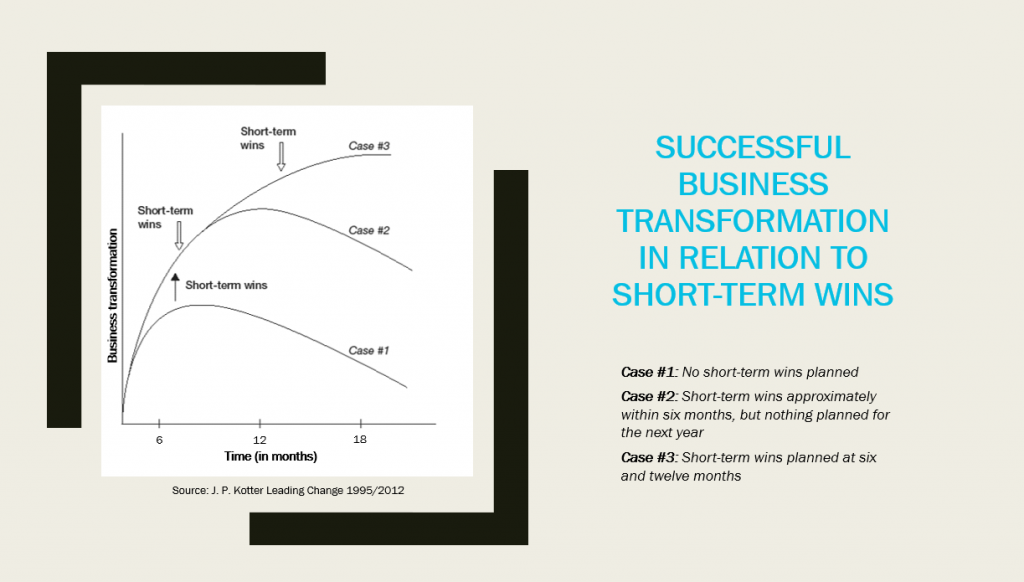Introduction
One week ago (19th of August) we published the fifth article in a series of eight about Change Management and the consequences for IT projects. It focused in-depth on empowering employees to act on the vision. Even when you have defined a clear Sense of Urgency, formed a powerful Guiding Coalition, created a clear Vision, and communicated it well, there will still be barriers that keep employees from executing the required Change. Step five in the model of Kotter is therefore to get rid of these barriers and by doing so, empower your employees and using all the potential in your company to implement Change successfully.
The experience from many different sources tells us that 75% of System Implementations fail to deliver their expected benefits. The one constant factor is that Change Management for People, Process and Technology is not appropriately addressed. Business leaders often do not realize enough how important this is or don’t know how to achieve it. Simply stated, but not so easily done.
This week we will look at step 6 (out of 8) of the model of Kotter: Planning for and creating short-term wins.
You are encouraged to read further if you want to ensure your project ends up in the 25% quadrant.
The model of John Kotter for Change Management
This model was introduced by John P. Kotter, leadership and change management professor at Harvard Business School, in his 1995/2012 book, “Leading Change”. The model defines eight key steps for change management, arguing that skipping any of the steps can be enough for the whole project to fail. Below we will go through step six of the model and show what it means for IT projects.
- Establishing a sense of urgency
- Forming a powerful guiding coalition
- Creating a vision
- Communication
- Empowering your employees
- Planning for and creating short-term wins
- Actions needed
- Define an engineer short-term wins
- Recognize and reward employees contributing to these wins
- Pitfalls
- Not planning for quick wins
- Consequences for IT projects
- Consider that there is no replacement for solid project management, but also keep in mind that implementations that take 9 – 12 months are not very attractive
- For this reason, a mix of a solid approach and an agile approach might be the best answer. This way you can realize some gains in an early stage. Seeing is believing!
- Actions needed
Planning for and creating short-term wins
Running a transformation effort without appropriate attention to short-term wins is extremely risky and can put all previously conducted change efforts at stake. Without appropriate attention, too many people could give up on the earlier provided support and join the group of people that were already resisting the change.
People would like to see evidence that all the effort is not for nothing. The nonbelievers go even further, they want to see change working well before they are finally convinced.
Kotter describes this as follows: “In a way, the primary purpose of the first six phases of the transformation process is to build up sufficient momentum to blast through the dysfunctional granite walls found in so many organizations. When we ignore any of these steps, we put all our efforts at risk. In enterprises that have been around for decades, the granite walls can be thick. Sometimes, extremely thick”.
The role of short-term wins is to help transformational change and it is at least sixfold. It can be described as follows:
- Provide evidence that sacrifices are worth it – Wins greatly help justify the short-term cost involved as well as reasoning why people would walk the extra mile.
- Reward change agents with a pat of the back – After a lot of hard work, positive feedback builds morale and motivation. The celebration of successes, even small ones, can boost the team spirit.
- Help fine-tune the vision and the strategies – Short-term wins give the Guiding Coalition concrete data on the viability of their ideas. Strategies to realize the vision might need some adjustments, the valuable input for improvements better arrives on time.
- Undermine cynics and self-serving resisters – Clear improvement in performance makes it difficult for people to block needed change. The ammunition for objections is taken out of the hands of the cynics and resisters. Generally, the more those are present in the company, the more important these short-term wins are.
- Keep managers on board – Provide those higher in the hierarchy with evidence that the transformation is on track. The provided evidence will prevent managers loosing faith.
- Build momentum – Turn people with a neutral attitude into supporters, reluctant supporters into active helpers, etc. Momentum is considered as critical as there is still tremendous effort to be done to finalize the change effort in the next stages.
Methods & Tools
In order to convince a large number of people of the vision in an early stage, you can define several sub-projects that can deliver the intended short-term wins. It is also strongly recommended to appoint one member of the Guiding Coalition to supervise these short-term wins. A properly defined short-term win has at least these three characteristics:
- It is visible – Large numbers of people can see for themselves whether the result is real or just a smokescreen.
- It is unambiguous – There can be little argument over the positive contribution.
- It is clearly related to the change effort – Without change effort, it would not materialize.
In smaller companies or smaller units of enterprises, short-term wins should become visible within three months. Larger organizations would allow some more time, between nine and twelve months. Regardless of the size of your company, you will have to run your short-term win projects in parallel with the main change effort. It is wise to plan other short-term wins thereafter in order to better support your business transformation, see the graph below:

Consequences for IT projects
When starting an IT project, it is essential that you explicitly plan for short-term wins in the form of the early delivery of one module or functionality, the creation of a proof of concept or a beta version of a release upfront that can be tested by Key Users. Apply an agile project approach for your short-term wins and pursue a solid project management methodology for the overall project. By doing so, you will create much better support for your project at an early stage. The progress on the realization of these short-term wins must be clearly present in the regular progress reports.
Align with the Guiding Coalition on what the short-term wins will exactly look like. The Guiding Coalition will have to drive the change effort, using these short-term wins as evidence for the implementation of the new vision.
Conclusion
Systematically planning for and creating short-term wins can prevent the entire change effort is put at stake. By doing so, you ensure the continuous support of many people that would otherwise give up the earlier provided support and join the group of people that were already resisting the change.
Did you realize all this when you started your last IT project? Proper Change Management is key for successful IT projects! If you want more information or you have specific questions, you can book a free consulting session on our website: www.Q7-consulting.com
